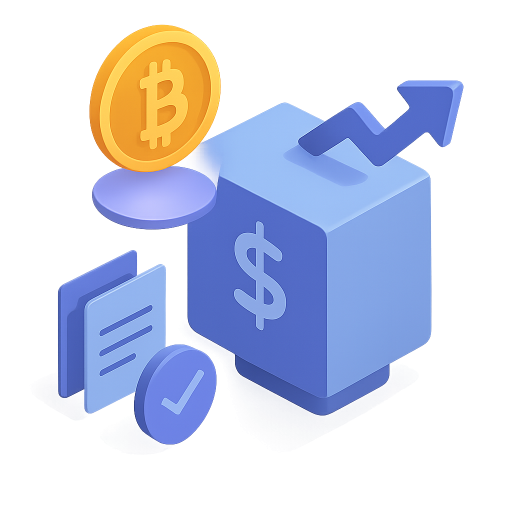Crypto Lending & Borrowing
Earn Interest on Your Assets
Intro | Types | Guide | Opportunities | FAQs

Introduction
What is Crypto Lending & Borrowing?
Crypto lending is the process of loaning your cryptocurrency to another party in exchange for interest, while crypto borrowing means taking a loan and using your own crypto assets as collateral. In simpler terms, it’s like a digital version of a traditional loan agreement, but using Bitcoin, Ethereum, and other coins instead of cash. These arrangements are facilitated by crypto lending platforms (either centralized companies or decentralized protocols) rather than banks.
How It Works: In a typical crypto lending scenario, lenders deposit their crypto into a platform which then makes those funds available to borrowers. Borrowers put up collateral (often worth more than the loan – a practice known as overcollateralization) and pay interest on the loan. Smart contracts or platform custodians ensure that if a borrower fails to repay, the collateral can be liquidated to cover the lender’s funds. This creates a system where lenders earn passive income and borrowers access liquidity without selling their holdings.
CeFi vs. DeFi: Crypto lending comes in two flavors – centralized finance (CeFi) and decentralized finance (DeFi). In CeFi, you use a custodial platform (similar to a bank) that takes custody of your crypto and manages the loans. In DeFi, loans are handled by smart contracts on blockchain, with no centralized intermediary. We’ll dive deeper into each in later sections, but the key difference is trust: CeFi requires trust in a company, whereas DeFi relies on trust in code.
Benefits of Lending
Why participate in crypto lending or borrowing? Here are the key upsides for both lenders and borrowers, making it a win-win in the crypto world.
- Passive Income on Idle Assets: For lenders, the biggest draw is earning interest on crypto that would otherwise sit idle. Instead of just “HODLing” coins in a wallet, you can put them to work and accumulate more coins over time. Many lending platforms offer yields far above traditional bank savings rates (often in the 5–10%+ APY range, and sometimes even higher), allowing you to compound your holdings while still retaining ownership of your crypto.
- Capital Efficiency for Borrowers: For borrowers, crypto loans provide liquidity without selling your assets. If you need cash or stablecoins but don’t want to sell your Bitcoin or Ethereum (perhaps because you expect them to rise in value), you can borrow against them. This way, you get funds for expenses or investments while your crypto collateral continues to benefit from any price appreciation. It’s a way of unlocking value from your holdings without giving them up.
- Competitive Interest Rates: Crypto-backed loans often have lower interest costs than unsecured loans like credit cards, because the collateral reduces the lender’s risk. As a borrower, you might find rates that are more attractive than those from traditional finance for similar loan types. As a lender, especially in certain markets, you might earn higher returns than any conventional savings product.
- Retaining Upside & Compounding Gains: A unique benefit in crypto is the ability for lenders to earn more of the asset they lend. For example, if you lend out 1 BTC at 5% APY, you’ll have 1.05 BTC after a year (before any price changes). If Bitcoin’s price rises during that time, you gain from the price increase and the extra 0.05 BTC earned. Borrowers likewise retain exposure to their crypto; if the collateral goes up in value, they still own that upside (assuming they repay the loan and reclaim the collateral). This dual benefit of earning yield while holding an appreciating asset can significantly boost long-term gains.
- Global and 24/7 Access: Crypto lending platforms (both CeFi and DeFi) operate online 24/7 and typically don’t have the geographic restrictions of traditional banks. This means anyone, anywhere can potentially lend or borrow crypto at any time, as long as they meet the platform requirements. It opens financial opportunities to people who might not have access to strong banking services, and it’s as simple as having an internet connection and some crypto.
Other perks include diversification of income streams, flexibility of loan terms, or the ability to use stablecoins to earn yield with minimal volatility. Overall, crypto lending empowers you to make your assets work harder in a dynamic market.
You might also face delays withdrawing from fixed-term lending, DeFi oracle glitches (price data errors), or tax obligations on earnings. Start small, spread your risk, and you’ll be ready to lend or borrow with confidence!
Risks of Lending
Crypto lending is an exciting way to grow your wealth, but it’s smart to know the potential bumps in the road. Here’s a friendly look at the key risks, with tips to keep things smooth and safe:
- Market Volatility & Liquidation Risk: Crypto prices can jump up and down. Borrowers, if your collateral’s value dips too much, you might need to add more or the platform could sell it to cover your loan (called liquidation). Lenders, big price swings might slow borrowing demand, affecting your interest. Tip: Borrow with a low loan-to-value (LTV) ratio, like 50%, use stablecoins for less volatility, and keep an eye on market trends.
- Platform/Custodial Risk: CeFi platforms hold your crypto, so a hack or company issue could impact your funds. DeFi is less exposed but still relies on platform stability. Tip: Pick trusted platforms with strong security (like 2FA or insurance), diversify your lending across multiple platforms, and consider DeFi for more control.
- Smart Contract Bugs (DeFi): DeFi runs on code, and rare glitches could lead to issues if exploited. Tip: Stick to well-tested protocols like Aave or Compound, which have solid track records, and look for platforms with insurance options.
- Interest Rate Fluctuations: DeFi rates shift with supply and demand, so your lending returns or borrowing costs might change. CeFi rates are usually steadier but can adjust over time. Tip: Check if rates are fixed or variable, and monitor platform updates to stay prepared.
- Custodial & Regulatory Risks: CeFi requires KYC, and changing regulations might limit access or lock funds temporarily. You also hand over your keys to the platform. DeFi skips KYC but depends on protocol rules. Tip: Stay informed about local laws, use DeFi for privacy if preferred, and only lend what you’re comfortable risking.
EXPLORE
Types of Lending and Borrowing
Lending and borrowing in crypto come in various forms, each designed to suit different financial goals – from earning steady interest on your assets to accessing liquidity without selling. Below, we break down the main types to help you choose the best approach for your needs.
CeFi Lending & Borrowing (Centralized Platforms)
CeFi platforms make lending and borrowing feel like using a digital bank—simple and guided, with a few trade-offs.
Custodial & User-Friendly
Platforms like Nexo, Binance Earn, or Coinbase operate as custodians—you deposit crypto into their wallet, and they lend it out to borrowers or use it for yield strategies, paying you interest. With intuitive apps and customer support, it’s beginner-friendly, mimicking a bank savings account experience.
KYC and Regulations
You’ll need to sign up and complete KYC/AML identity verification. Platforms comply with regulations, which may restrict access in some regions (e.g., U.S. limits on Coinbase lending). This adds accountability but reduces privacy.
Interest Rates and Terms
CeFi offers fixed or variable rates, typically 4–8% APY for BTC/ETH, 8–12% for stablecoins. Flexible terms allow withdrawals anytime (lower rates), while fixed-term (e.g., 1-3 months) locks offer higher yields. Rates may adjust monthly—check platform updates.
Examples of CeFi Platforms
- Nexo: Up to 8% APY on Bitcoin, 12% on stablecoins; instant loans with ~50% LTV. Offers insurance and a NEXO token for rate boosts. [Explore Nexo Review]
- Binance Earn: Easy lending with flexible or locked options; promotional high-yield periods. Ideal for Binance users. [Explore Binance Earn Review]
- Coinbase (Borrow): Borrow cash against BTC (up to 40% LTV, fixed APR). Simple but limited availability. [Explore Coinbase Review]
Pros and Cons
Pros: Easy to use, no blockchain knowledge needed, often insured deposits, customer support. Cons: Custodial risks (hacks, insolvency), less transparency, KYC required. Use reputable platforms and don’t overcommit funds.
Margin & P2P Lending Models
Not all crypto lending uses pooled models—margin and peer-to-peer (P2P) lending offer alternative ways to earn or borrow.
Margin Lending on Exchanges
Some cryptocurrency exchanges offer margin trading features, and to facilitate that, they allow users to lend funds to margin traders. In this setup, your funds are lent to other traders on the exchange who are trading with leverage. The exchange acts as an intermediary: it matches lenders and borrowers and manages the collateral and liquidation processes.
How It Works: If you opt in to margin lending (sometimes called “funding” on exchanges like Bitfinex or “lending” on others), you typically choose an asset and set an interest rate you’re willing to lend at. Margin traders who want to borrow that asset will borrow from the pool of funds (at the lowest available rates) to execute their trades. As a lender, you earn interest as those traders pay for borrowing. Exchanges often calculate and pay interest on an hourly or daily basis. For example, on VALR, when you lend, your funds get matched with borrowers automatically, and you earn yield hourly, with rates fluctuating based on demand.
High APY Potential: Margin lending rates can sometimes be very high, especially during periods of market volatility or high leverage demand. It’s not unheard of to see double-digit or even triple-digit APRs for short periods. For instance, if there is huge demand to short a particular coin, borrowers might be willing to pay extremely high interest for a few days to get the coins they need. Some platforms have seen certain assets hit 100%+ APR on an annualized basis for lenders during peak demand. However, these situations are usually temporary. Lenders should be aware that such high rates often normalize quickly, and chasing them might require active management.
Risk Management: When you lend for margin trading, the exchange typically protects lenders through collateral requirements and automatic liquidations. Every margin trader has to maintain a margin ratio; if their trade goes the wrong way and their collateral value falls too low, the exchange will liquidate their position to repay the borrowed assets (plus fees) before the lender would take a loss. Many exchanges also have an insurance fund or guarantee fund that covers lenders if a sudden, extreme market move leaves a shortfall (for example, if prices crash too fast and even liquidation can’t cover the loan). If a margin trader cannot repay, positions are liquidated and an insurance fund covers any remaining shortfall so that lenders are made whole. This means the risk of lender loss is minimized, but it’s not zero – catastrophic market events or exchange failures can still lead to issues.
User Experience: Margin lending usually requires you to hold funds on the exchange and then move them into the exchange’s lending or funding wallet. You may have options to set your own interest rate or lend for a fixed term (e.g., 7 days, 30 days) or use an auto-lend feature where the exchange lends out your idle balance at the prevailing market rate. It’s somewhat more hands-on than CeFi lending, but some users enjoy the ability to specify rates and terms. The exchange handles all matching and payments, so from the user’s side it feels like earning interest with a bit more configuration. Keep in mind, by doing this you have the same custodial risk as leaving funds on an exchange (hacks, insolvency, etc.), so it’s crucial to use reputable exchanges and not lend more than you can afford to lose.
Examples: Bitfinex’s margin funding market is well-known, where users post offers with desired interest rates. Binance’s “Isolated Margin” and “Cross Margin” features use a pool of funds – on Binance, lenders are essentially the other users who have enabled “earn” on their idle assets, though Binance abstracts it away.
DeFi Lending & Borrowing (Decentralized Protocols)
DeFi puts you in control, using blockchain smart contracts for trustless lending and borrowing.
Non-Custodial & Permissionless
No company holds your funds—you interact with protocols like Aave via wallets (e.g., MetaMask). No KYC, just a wallet and crypto, making it open globally for anyone with internet access.
Overcollateralization & Smart Contracts
Loans require collateral (e.g., $150 ETH for $100 stablecoin). Smart contracts manage rates, payouts, and liquidations transparently, with rules often adjustable via community governance. You see everything on-chain.
Variable Interest Rates
Rates shift with supply/demand (1–5% for ETH, 5–15% for stablecoins). Aave offers “stable” rates for less volatility; fixed-rate options like Notional are emerging. Expect dynamic changes.
Key DeFi Protocols
- Aave: Multi-chain, supports dozens of assets, with variable/stable rates and flash loans. Known for robust security. [See How to Use Aave]
- Compound: Ethereum-based, simple lending with cTokens and COMP rewards. Great for integration.
- MakerDAO: Borrow DAI against collateral (e.g., ETH); cornerstone of DeFi with stablecoin focus.
Pros and Cons
Pros: Full control, transparency, no KYC, token rewards. Cons: Technical complexity, gas fees (especially Ethereum), smart contract risks. Use audited protocols and start small
Peer-to-Peer Crypto Lending
Peer-to-peer lending refers to a model where individual lenders and borrowers connect directly, rather than borrowers drawing from a common pool. In crypto, pure P2P lending platforms exist where a borrower posts a loan request listing how much they want, what collateral they offer, the purpose of the loan, and at what interest rate they’re willing to pay. Lenders can then choose to fund that specific loan.
How It Works: A borrower creates a loan listing with details like amount, desired term, interest rate, and collateral (if required). Lenders on the platform can browse these listings and decide to fund loans that meet their risk/reward appetite. A loan could be funded by one lender or split among many lenders (e.g., 10 lenders each contribute 10% of the loan). Once the loan is fully funded, the platform or a smart contract will disburse the funds to the borrower, often by holding the borrower’s collateral in escrow. The borrower then makes periodic interest payments (and eventually repayment of principal), which the platform passes on to the lenders. Everything is facilitated by the platform’s system of smart contracts or internal accounting, which ensure that if the borrower defaults, the collateral goes to the lenders.
Use Cases & Flexibility: P2P lending can accommodate loans that don’t fit the standard overcollateralized model. For example, a borrower might seek an undercollateralized loan (less collateral than loan value) or even an unsecured loan based on reputation or credit scoring. These are riskier for lenders, so they often come with higher interest rates. Some crypto P2P platforms attempted to do credit checks or use social trust metrics to allow this. However, this area is very risky and relatively rare, as the crypto ethos leans towards collateralized loans. More commonly, P2P crypto loans might still be overcollateralized, but allow negotiation of terms: a borrower might offer a higher interest to entice lenders, or use a specific altcoin as collateral that big protocols don’t support. It’s a way to handle more niche needs.
Examples: In the past, platforms like BTCjam and Bitbond facilitated Bitcoin P2P loans (often unsecured small loans) – but defaults were a big problem. Today, decentralized P2P-style lending exists in projects like Atomic Loans, and even within large protocols via special features (Compound’s API could be used to set up pseudo-P2P, and Aave’s credit delegation allows a form of P2P trust-based lending). However, most DeFi has moved to pooled lending as it’s more efficient. On the CeFi side, some platforms like SALT and Unchained Capital offer one-to-one loans (you and the company, effectively P2P with the company as intermediary) where terms can be customized. Also, newer marketplaces might emerge that directly connect parties for specific loan deals (especially for large institutional loans or OTC deals, which might then be tokenized).
Risks: P2P lending carries all the usual risks plus potentially higher default risk if loans are not fully collateralized. Lenders must carefully evaluate individual borrowers (if information is provided) and possibly take on the risk of someone not paying back. The platform might have measures to pursue the borrower or use collateral, but unlike pooled lending, a single default directly hits those specific lenders’ funds. There’s also liquidity risk: if you fund a loan for 6 months, you can’t withdraw your funds until the term ends (unless the platform provides a secondary market to sell your loan share). P2P is for advanced users who understand the risks, and beginners are generally better off with the more automated CeFi or DeFi platforms.

LEARN
How to Start Lending or Borrowing Crypto
Ready to get started? Here’s a step-by-step guide for both lending and borrowing crypto. We’ll separate the processes since they differ, and note CeFi vs. DeFi variations.
Starting as a Crypto Lender (Earning Interest)
- Choose a Platform or Protocol: Decide between CeFi (e.g., Nexo) for ease or DeFi (e.g., Aave) for control. Compare based on rates, reputation, and assets.
- Set Up Account or Wallet: For CeFi, sign up and complete KYC with 2FA. For DeFi, set up a wallet like MetaMask with gas funds.
- Deposit or Transfer Crypto: Send assets to the platform (CeFi) or approve and deposit into the smart contract (DeFi).
- Select Lending Terms: Choose flexible or fixed if available; in DeFi, deposit is usually all that’s needed.
- Earn Interest & Monitor: Interest accrues—check dashboards for changes. Compound by reinvesting.
- Withdraw Your Funds: Request withdrawal when ready, noting any fees or locks.
Starting as a Crypto Borrower (Taking a Loan)
- Choose a Lending Platform/Protocol: Select based on collateral, borrow assets, rates, and LTV.
- Account or Wallet Setup: KYC for CeFi; wallet for DeFi.
- Deposit Collateral: Transfer collateral and earmark for the loan.
- Borrow Assets: Enter amount, confirm terms, and receive funds.
- Use the Borrowed Funds: Spend as needed while interest accrues.
- Monitor Collateral & Loan Health: Watch LTV; add collateral or repay if needed.
- Repay the Loan: Pay back principal and interest to unlock collateral.
Borrow conservatively to avoid liquidations. See our platform-specific guides for details.

LEARN
How Interest Rates Work in Crypto Lending
Interest rates drive crypto lending—here’s how they function, key terms, and what influences them.
APR vs. APY: APR is the simple annual interest rate without compounding; APY includes it for the true yield. E.g., 10% APR compounded monthly is ~10.47% APY. Crypto platforms often use APY for lending, APR for borrowing.
Variable vs. Fixed Rates: Variable rates (common in DeFi) fluctuate with supply/demand; fixed rates lock in for terms (more in CeFi). Choose fixed for certainty.
Supply and Demand Dynamics (Utilization): Rates rise with high borrowing/low supply. DeFi uses utilization curves—e.g., 5% at 50% utilization, spiking at 90%.
Asset Volatility and Risk Premium: Volatile assets may have higher rates; stablecoins often yield more due to demand.
Platform-Specific Factors: CeFi boosts with tokens; DeFi with incentives. Fees reduce net rates.
Token Incentives (“Liquidity Mining”): Extra tokens can boost effective APY, but they’re temporary.
Typical Rate Ranges: BTC/ETH: 3-8% APY; stablecoins: 6-12%—higher in demand spikes.
Fixed-Rate Protocols: Notional or Yield offer locked rates via DeFi.
High yields often mean higher risk—understand the source.
Monitor
Real-Time Lending Opportunities
Below is a real-time table of current lending rates on various platforms for popular assets as of July 21, 2025. Use this to gauge where to earn the best return or borrow cheaply—rates change quickly, so verify on the platform.
| Asset |
Platform (CeFi/DeFi)
|
APY (Lending)
|
|---|---|---|
|
USDC
| Aave (DeFi) |
5-12%
|
| BTC |
Nexo (CeFi)
|
4-8%
|
|
ETH
| Compound (DeFi) | 1-5% |
|
USDT
|
Binance Earn (CeFi)
|
6-10%
|
|
DAI
|
MakerDAO (DeFi)
|
5-15%
|
| USDC |
Bitstamp (CeFi)
|
Up to 6%
|
| BTC |
Hodlnaut (CeFi)
|
Up to 7.25%
|
These are indicative—factors like utilization affect them. See our platform reviews for more.
Understand
How We Review Lending Platforms

Interest Rates & Yield Offerings
Competitive, sustainable rates; we check base yields and bonuses.

Liquidity and Market Size
Deep TVL for easy deposits/withdrawals; avoid low-liquidity risks.

Security & Safety Measures
Audit history, insurance, no hacks; prioritize audited smart contracts.

Transparency & Trustworthiness
Clear operations, proof-of-reserves, regulatory compliance.

User Experience (UX) & Support
Intuitive interfaces, responsive help; good for beginners.

KYC & Accessibility
Note requirements and global availability.

Collateral and Supported Assets
Wide, reliable options without high-risk tokens.

Fees and Terms
Low hidden costs, flexible terms.

Innovation & Future Outlook
Features like flash loans or multi-chain support.
Clarify
FAQs About Crypto Lending & Borrowing
Is crypto lending safe?
Crypto lending involves risks, but it can be done safely with reputable platforms and conservative strategies. Key threats include volatility, hacks, and smart contract bugs—mitigate by diversifying and using insured services. Never risk more than you can lose.
Can I lose my crypto by lending it out?
Yes, if the platform fails or gets hacked, or in extreme volatility. Overcollateralized loans protect against defaults, but always research security.
What happens if I can’t repay a crypto loan?
The platform liquidates your collateral to cover the debt, plus penalties—you lose the sold portion. Monitor LTV to avoid this.
How does collateralization work in practice?
Lock collateral worth more than the loan (e.g., 150% ratio). If value drops, add more or repay to prevent liquidation.
Are earnings from crypto lending taxable?
Yes, interest is often taxable income—track values when received. Consult a tax professional, as rules vary.
Do I have to undergo KYC to use crypto lending platforms?
CeFi requires KYC; DeFi does not—just a wallet.
Which is better for me, CeFi or DeFi lending?
CeFi for ease and support; DeFi for control and privacy. Mix based on needs—beginners often start with CeFi.
Can I get a crypto loan without collateral (unsecured loan)?
Rare in crypto—most require collateral. Flash loans are unsecured but short-term; avoid “no-collateral” offers as scams.
What cryptocurrencies should I lend to get the best return?
Stablecoins like USDC for steady 6-12% APY; BTC/ETH for 3-8%. Check real-time rates—high yields mean higher risk.
Glossary of Lending & Borrowing Terms
-
- APY (Annual Percentage Yield): The annualized return including compounding; e.g., 10% APY grows $100 to $110 yearly with reinvestment.
- APR (Annual Percentage Rate): Simple annual interest without compounding; often for borrowing costs.
- Overcollateralization: Providing more collateral than the loan value; e.g., $150 collateral for $100 loan.
- Loan-to-Value (LTV) Ratio: Loan amount vs. collateral value; e.g., 50% LTV is safe.
- Margin Call: Warning to add collateral or repay when LTV rises.
- Liquidation (and Liquidation Penalty): Automatic collateral sale on default; penalty fee (5-15%) applies.
- Health Factor: DeFi metric for loan safety; above 1 is secure.
- Stable Yield: Consistent rate, often on stablecoins or fixed terms.
- Flash Loan: DeFi instant loan repaid in one transaction, no collateral.
- Oracle: Provides real-time prices to smart contracts for accurate valuations.
